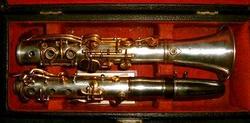 Conn HP Albert Clarinet Conn HP Albert Clarinet This idea for a post came from a customer question: 'how can I tell the difference between LP and HP clarinets?" Its a damn good question! For those of you who aren't familiar with the terms, LP stands for Low Pitch (A=440) and HP for High Pitch (approx. A=456). The latter was a pitch system in use in Europe in the late 19th/early 20th cen, and crossed the ocean with emigres bearing clarinets. Thankfully, it died out in the 30's, as the two systems are about a quarter tone apart and little or nothing can be done, (with longer barrels, etc.), to reconcile the two! You'll see these poor beasties on eBay with some frequency and they always have a lonely, under-appreciated look to them, generally selling for $30 or $40 to someone who didn't ask for markings or measurements and thinks they're getting a hell of a deal! Well, they are, after a fashion: I've had a couple show up here and had to sit the owners down, with a box of Kleenex, and explain the harsh realities of multiple pitch systems to them. The sad thing is that identification is not difficult! In the 1920's, with LP ascendant and HP on the way out, most instruments were marked one or the other on the main body sections. Before that, especially with European made instruments, you have to depend on measurements. A modern Bb clarinet is 23 1/4" assembled, without the mouthpiece. I've seen older examples that varied from 23 to 23 1/2", but nothing longer or shorter than that. By the time you're down to 22 7/8 or a bit less, you're looking at a Bb HP. Shun it! Run away! It will make a wonderful lamp or doorstop, but its days as a musical instrument are sadly past, unless you like playing clarinet by yourself... On my Blogspot page, I have provided a chart of lengths for HP and LP clarinets in all the common keys (and a couple rare ones). The URL is http://vintageclarinetdoctor.blogspot.com/p/blog-page_14.html , if you'd like to check it out....
1 Comment
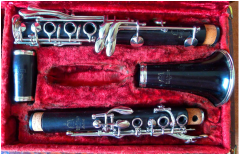 1940's Penzel Mueller Artist Clarinet 1940's Penzel Mueller Artist Clarinet After years of refurbishing Penzel Mueller clarinets, I'm still amazed at the obscurity in which they linger! From a buying point of view, great: from a selling point of view, not so good. So, here's a little info to pique your interest in this unjustly forgotten brand. The company was started by 2 German immigrants, Penzel and Mueller, in the early 1890's in Long Island City NY. They offered a variety of clarinets and flutes, as well as some saxes and brass which I suspect were made by someone else and stencilled with the PM logo. If someone can shed more light, please do! The company operated through the late 1950's (as best I can determine), before ceasing production. Their clarinets (especially the Artist, Studio Recording, and Super Brilliante models) were top of the line horns, easily comparable to anything coming out of Europe during the period. Woody Herman played an Artist model, in fact. The tone was more 'American' than 'French' in concept - think Conn rather than Buffet - great for Jazz as well as concert music, freeblowing, more direct than sweet. Intonation is very good on most of the horns I've tried, and the keywork is comfortable unless you have very small hands: there's a bit of a spread, which is welcome for us large fingered folk! A customer in Texas was kind enough to forward a model/price list from their 1955 catalog: Super Brilliante $340 Artist, new model $265 Empire $265 Bel Canto $185 American Professional $165 Soloist $149.50 Dyna-Tone $139.50 Standard Model $129.50 The only one I've worked on that I don't see here is the 'Studio Recording' model, which was a pro horn that came with 3 barrels. Perhaps it had been discontinued by 1955? Anyway, I hope this is enough to get you to keep an eye out for one of the better PM's in good playing condition. Regardless of the style you play, I believe you'd enjoy it. *Re-posted from 2012 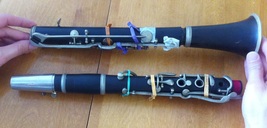 1920's Vocotone Albert System Clarinet 1920's Vocotone Albert System Clarinet I buy most of my horns on eBay and have learned, through long and expensive experience, to examine every instrument with a fine toothed comb before purchasing! I've received cracked clarinets, plastic instead of wood clarinets, broken clarinets, clarinets with damaged or missing keys or rings, and even a clarinet that was made of pieces of 3 different clarinets! So, based on my experience and some of the customer horns I've been seeing lately (also purchased on eBay) I'd say its time for an eBay buying tutorial! First, I'd restrict my buying to the US and Canada unless you are fluent in another language and can afford to risk the high shipping. Mistakes can happen with overseas communication, and it can be much harder and more expensive to force a return if things aren't as represented! Second, look at feedback: while feedback can't tell you everything (with one negative, ebay's current policy of basing it on only the last year's transactions can make a small seller look worse than he/she is) it is a good place to start. Numerous negatives/ neutrals and unflattering comments about misrepresented condition, poor communication, and high shipping can be a tip off that you aren't dealing with someone who is professional or honest - best to move on; lots of fish in the sea... Third, what does the ad show and tell you? Is it full of sharp pictures and copious details or a few badly taken pictures and a very skimpy description posted from a mobile phone? Is the person obviously knowledgeable and informative about the instrument, or just a garage sale picker looking for a quick sale at the highest price? Fourth, is there a return policy? Honest, knowledgeable sellers know that mistakes can happen, especially if they are selling something that they are not familiar with - I had to return a clarinet just a few weeks ago, as the ad failed to show or mention that the upper half of the bridge key was broken off and missing! Luckily, she was honest and pleasant about it, but I haven't always been so lucky. Ebay will sometimes assist you in forcing a return if an item has been misrepresented, but it is a troublesome process and they keep track of how often you use it: too many returns, and you risk losing access to the service, whether you are in the wrong or not! So, fifth and last - ask questions! Here are some of my favorites: 'Is the instrument in playable condition?' 'Are all pieces wood?' 'Do all pieces have logos that match?' 'Are there any cracks, chips, repairs, or any missing, damaged or frozen keys?' 'What is your return policy?' If you get what seem like thoughtful, honest answers, their feedback is in an acceptable range, and the photos look good, you are most likely safe to go ahead. If you receive no answer or something like "I know nothing about clarinets but it looks good to me" (one of my favorites) then be prepared to pass, or set a bid at a low price, or ask more questions. Also, avoid tunnel vision or 'gotta have it' syndrome: there are lots of clarinets for sale this week and there will be next week, too. If you're not a 100% percent satisfied with what you are looking at, look some more. Remember, its just a clarinet.... * Re-posted from 2012 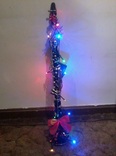 Hi Folks, I've been preparing for the holiday season by laying in a stock of vintage Boehm and Albert system clarinets, reeds, mouthpieces, barrels, reed trimmers, reed cases and even an alto sax! If you have a moment and a need, I'd appreciate it if you'd take a look at : http://www.thevintageclarinetdoctor.com/shop.html and http://www.thevintageclarinetdoctor.com/mouthpieces.html Thanks to all of you for your support in the last six years, and have a safe and happy holiday! Best wishes, Jeremy Soule Starting a new musical instrument is always challenging, but clarinet has its own wrinkles that need to be addressed for young students and unwitting parents. My cousin Shylo in WA just wrote asking for advice for her son, who is 11 and just starting the clarinet. Here is my response:
1) Get a good mouthpiece, not plastic. It makes a huge difference. A Portnoy bp02 is a good place to start, and they turn up used on eBay for $30-50. 2) Get a good ligature (thing that holds the reed on). A Rovner is about $20 on Amazon and allows the reed to vibrate freely and evenly (cheap metal ligs can pinch) and sounds better. 3) Buy a couple Fibracell reeds. They are a synthetic material that looks like a regular reed, but don't have to be soaked before each use, and don't squeak, split, chip, warp, are easier to get a good sound out of, and last for months. They cost about $13 each, but 2 or 3 would probably last him a year if he's careful with them. 2.5 would be a good strength for a beginner. If he decides to stick with clarinet, he can move to natural reeds in a couple years: they have a slightly better tone but are fragile, require adjusting and wetting, have a shorter life and you won't get 10 good ones in a box of 10! 4) Make sure that, even if he's playing an inexpensive student horn (plastic) that its a decent brand, like Yamaha, Bundy, Vito or Buffet, (not some Chinese POS) and that all the pads seal and it is properly adjusted. A horn that has even a small leak can be a nightmare to play well, play in tune, etc. and is really frustrating for a child who hasn't developed skills for delayed gratification. 5) Buy or download a clarinet fingering chart, to figure out what all those buttons do! Clarinets are complicated and there is often more than 1 way to play the same note. 6) It would be a good idea to get a beginner lesson or 2 for both of you from a local teacher, just to get you off on the right foot. Once someone shows you the right way, you'll get it. Starting with a poor setup or bad mouth position is only going to result in frustration, limited technique, and probably retraining down the road... Hope that helps! Holiday hugs, Jeremy |
Archives
February 2024
AuthorThe Licorice Shtick Blog is the creation of the Vintage Clarinet Doctor, a Winston Salem, NC based woodwind instrument repair shop specializing in vintage and antique clarinets, saxophones, and the occasional flute. Categories |
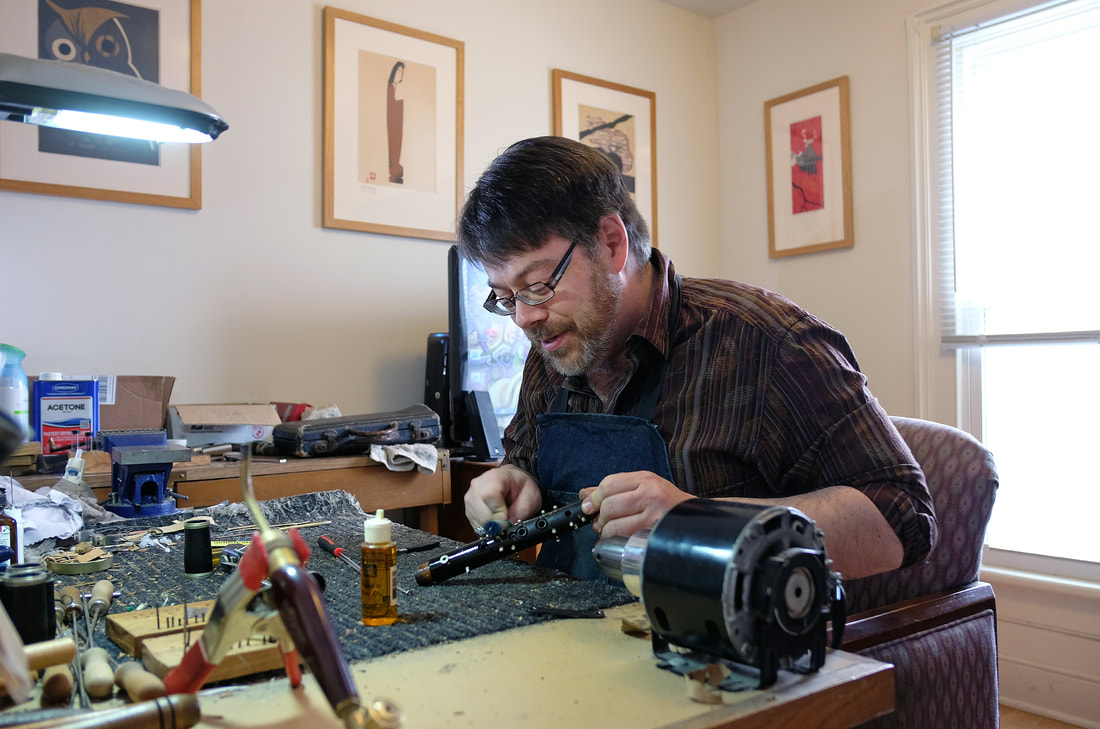
 RSS Feed
RSS Feed